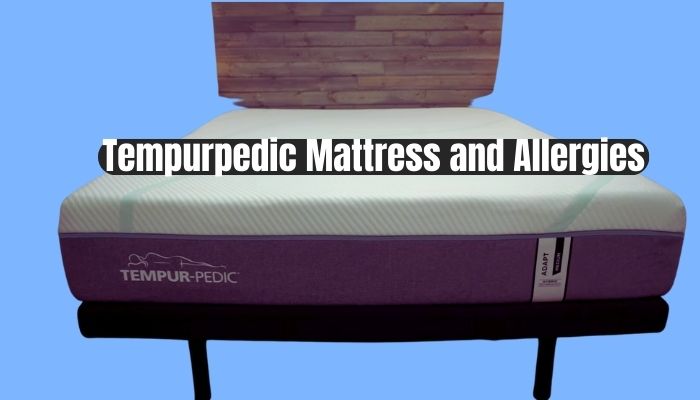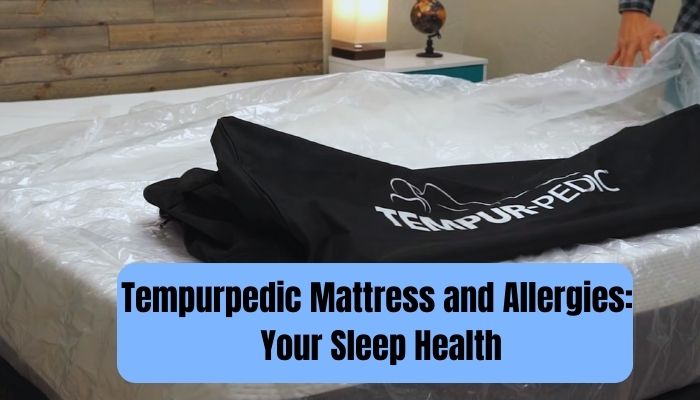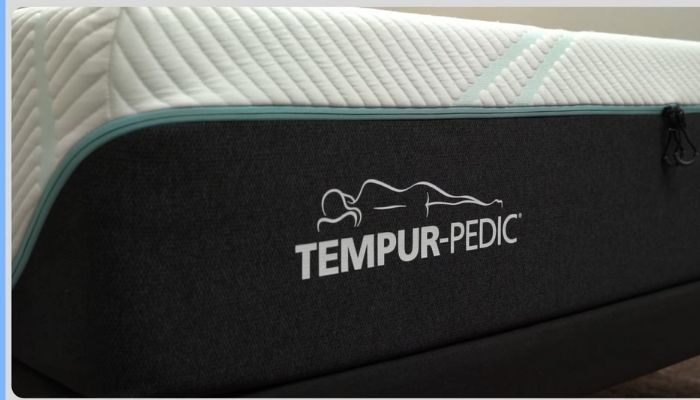Explore the in-depth analysis of Tempurpedic mattresses and allergies. Discover how these high-tech beds can impact your sleep quality and allergy triggers.
Understanding Tempurpedic Mattresses: An Overview
In the realm of sleep technology, Tempurpedic mattresses represent an innovation that bridges the gap between comfort and support. In this article, we delve into the intricacies of Tempurpedic mattresses and dissect the technology behind them, alongside their hypoallergenic claims.
The Technology Behind Tempurpedic Mattresses
At the heart of every Tempurpedic mattress is the exclusive Tempur material. This proprietary innovation is a high-density viscoelastic foam initially designed by NASA to cushion astronauts during lift-off. It precisely adapts to your body, providing superior comfort and support.
The ability of the Tempur material to distribute pressure evenly across the mattress surface sets it apart. It ensures that no single point on your body bears the brunt of pressure, aiding in maintaining proper spinal alignment and promoting muscle relaxation.
Tempurpedic mattresses also incorporate cooling technology, a crucial feature for maintaining the ideal sleeping temperature. The Tempur-Breeze line, for instance, leverages a system of cutting-edge materials to dissipate heat and ensure a calm, restful sleep.
The Hypoallergenic Claims of Tempurpedic Mattresses
Tempurpedic mattresses claim to be hypoallergenic, providing a haven for those who suffer from allergies. But what does this mean?
Primarily, hypoallergenic means that the materials used in the mattresses are unlikely to cause an allergic reaction. Tempurpedic mattresses are designed with antimicrobial fabrics that resist the growth of mold, mildew, and dust mites – common allergens that can trigger reactions in sensitive individuals.
Moreover, the dense nature of the Tempur material prevents allergens from penetrating the mattress, further safeguarding against allergic reactions. So, the unique construction and thoughtful design of Tempurpedic mattresses contribute to their hypoallergenic credentials.
Are Tempurpedic Mattresses Allergy-Proof?
Understanding the hypoallergenic claims of Tempurpedic mattresses leads to another pertinent question – are these mattresses completely allergy-proof?
Briefly, no mattress can claim to be 100% allergy-proof. However, Tempurpedic mattresses significantly minimize the risk of allergens infiltrating your sleeping environment. Their closed-cell structure creates a barrier against dust mites and other allergens, thus substantially reducing the potential for allergic reactions.
Moreover, the removable and washable covers of Tempurpedic mattresses add another layer of protection. Regular washing can help eradicate potential allergens that accumulate over time, maintaining a clean and hygienic sleep environment.
Despite these preventive measures, it’s crucial to complement the hypoallergenic properties of your Tempurpedic mattress with clean bedding, regular vacuuming, and maintaining a low humidity level in your bedroom. This multi-pronged approach will ensure your sleeping environment remains as allergy-proof as possible.
Read more about Should I Rotate My TempurPedic Mattress? – Care Tips
The Science Behind Allergies and Mattresses
We must first investigate the causes of allergic reactions in order to fully understand the relationship between allergies and mattresses. When the immune system overreacts to environmental chemicals known as allergens, allergies develop.
Dust mites, mould spores, and certain proteins are examples of common allergies in mattresses. These allergens can cause symptoms including itching, sneezing, and congestion when breathed or in contact with the skin.
Conventional mattresses have the drawback of being the perfect place for allergies to flourish. Dust mites and moulds thrive in warm, humid environments with dead skin cells present, which can exacerbate allergy symptoms in people with delicate immune systems.

Tempurpedic and Dust Mites: What You Need to Know
Regarding dust mites, Tempurpedic mattresses take a solid defensive stance. Dust mites, microscopic creatures that feed on dead skin cells, are a leading cause of indoor allergies. With their open-cell structure, regular mattresses often become a habitat for these critters, negatively impacting your sleep health.
Tempurpedic mattresses, however, are built with a closed-cell structure. This unique construction design inhibits dust mites from penetrating the mattress core, thus reducing their numbers significantly. The dense, viscous Tempur material doesn’t offer the hospitable environment that dust mites seek, thereby minimizing allergenic impacts.
Tempurpedic Mattress Materials: A Deep Dive
Now, let’s delve into the materials that compose a Tempurpedic mattress. At its core, the Tempur material, a type of viscoelastic foam, forms the bedrock of the mattress. It is not only pressure-relieving but also dense enough to prevent allergen penetration.
The fabric coverings of Tempurpedic mattresses also warrant attention. They use high-performance fabrics which are both durable and soft to the touch. Removable and washable covers allow you to maintain a hygienic sleep surface.
Advanced models incorporate phase-changing material (PCM) to control the mattress’s temperature, making them an attractive option for hot sleepers.
Understanding CertiPUR-US® Certification in Tempurpedic Mattresses
The CertiPUR-US® certification is a gold standard in the mattress industry. This certification guarantees that the foam used in the mattress is free from harmful chemicals such as heavy metals, formaldehyde, and phthalates. It also ensures that the mattress is low in volatile organic compound (VOC) emissions, which can negatively impact indoor air quality.
Tempurpedic Mattresses proudly hold this certification, reiterating their commitment to providing a sleep surface that is comfortable, supportive, and safe. The CertiPUR-US® certification of Tempurpedic mattresses adds another layer of assurance, particularly for allergy sufferers and those with chemical sensitivities, elevating the overall sleeping experience.
Tempurpedic and Off-Gassing: Facts and Myths
Tempurpedic mattresses have gained significant popularity in recent years for their superior comfort and support. However, with increasing awareness about indoor air quality, concerns about off-gassing from memory foam mattresses like Tempurpedic have also emerged. This article aims to delve into the facts and myths surrounding Tempurpedic and off-gassing, provide valuable tips to maximize the health benefits of your Tempurpedic mattress, share effective cleaning techniques, and explore lifestyle changes to manage allergies for better sleep.

Tempurpedic and Off-Gassing: Understanding the Truth
What is Off-Gassing?
Off-gassing refers to releasing volatile organic compounds (VOCs) from certain materials, including memory foam used in Tempurpedic mattresses. These VOCs can emit a faint odor, commonly described as a “new mattress smell.” While it might be concerning for some, it is essential to understand that off-gassing is common in various products like new furniture, carpets, and even paint.
The Reality of Off-Gassing with Tempurpedic Mattresses
The off-gassing associated with Tempurpedic mattresses is relatively mild and temporary. The VOCs released are generally considered safe and non-toxic for healthy individuals. The odor usually dissipates within a few days to a couple of weeks after the mattress is unpacked and allowed to breathe. The brand’s commitment to using CertiPUR-US® certified foam ensures that its products meet strict standards for emissions and content, providing customers with peace of mind.
Separating Myths from Facts
Numerous myths have circulated about off-gassing, often causing unnecessary alarm among potential buyers. Some common myths include linking off-gassing to severe health issues and long-term effects. However, scientific research and studies have shown that the levels of VOCs released from Tempurpedic mattresses are well within the safe limits defined by regulatory bodies.
Read more about How to Move a Tempurpedic Mattress Safely: The Ultimate Guide
Maximizing the Health Benefits of Your Tempurpedic Mattress
Investing in a Tempurpedic mattress is a step towards enhancing your sleep quality and overall well-being. To make the most out of your investment, follow these tips to maximize the health benefits:
- Choose the Right Firmness Level
Tempurpedic mattresses come in various firmness levels, each catering to different sleeping preferences. Take your time to select the one that aligns with your needs, whether you prefer a soft, medium, or firm mattress. Proper support is essential to maintain your body’s natural alignment during sleep.
- Use the Right Pillows
Pairing your Tempurpedic mattress with suitable pillows is crucial for optimal neck and spine alignment. Memory foam pillows can complement the mattress, providing excellent support for your head and neck.
- Maintain Good Sleeping Posture
Even with a high-quality mattress, your sleeping posture plays a significant role in determining sleep quality. Avoid sleeping on your stomach, as it can strain your neck and back. Instead, try to sleep on your back or side to keep your spine correctly aligned.
- Keep Your Mattress Clean
Regularly cleaning your Tempurpedic mattress is essential to maintain a healthy sleep environment. Follow the manufacturer’s guidelines for cleaning and spot-treat any stains promptly.

Cleaning Tips for Your Tempurpedic Mattress
A clean mattress ensures not only better sleep but also prolongs the life of your Tempurpedic mattress. Here are some practical cleaning tips:
- Vacuum Regularly
Dust, dirt, and debris can accumulate on your mattress over time. Use a handheld vacuum cleaner with a soft brush attachment to remove surface dust regularly.
- Spot Clean Stains
If spills or stains occur, tackle them immediately to prevent them from setting. Use a mild detergent diluted in water and gently blot the stained area with a clean cloth. Avoid soaking the mattress.
- Deodorize Naturally
Sprinkle baking soda over the top and let it stay for a few hours to keep your mattress smelling fresh. After that, hoover the baking soda to get rid of any smells.
Managing Allergies for Better Sleep: Lifestyle Changes to Consider
Allergies can disrupt sleep and make your nights uncomfortable. While Tempurpedic mattresses are hypoallergenic, some lifestyle changes can further alleviate allergy symptoms:
- Keep Your Bedroom Clean
Regularly dust and vacuum your bedroom to reduce dust mites and allergens. Use allergen-proof mattress and pillow covers to prevent dust mites from accumulating.
- Maintain Optimal Humidity
Keep your bedroom’s humidity levels between 30% to 50% to discourage the growth of mold and mildew, common allergens.
- Wash Bedding Frequently
Wash your bedsheets, pillowcases, and blankets in hot water once a week to eliminate allergens and keep your sleeping environment fresh.
- Choose Allergen-Free Bedding
Consider using hypoallergenic bedding materials to minimize exposure to potential allergens.
Conclusion
In conclusion, Tempurpedic mattresses offer outstanding comfort and support, with minimal and temporary off-gassing that poses no health risks. By understanding the facts and myths about off-gassing, you can make an informed decision when investing in a Tempurpedic mattress. To maximize the health benefits of your mattress, choose the right firmness level, use appropriate pillows, maintain a good sleeping posture, and keep your mattress clean.
